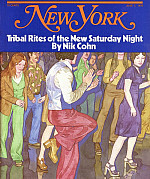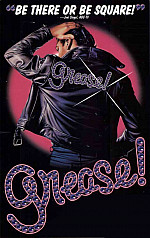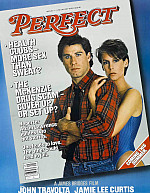7
Featured Events
2009After performing the Poison hit "Nothin' but a Good Time" at the Tony Awards, Bret Michaels has a run-in with the set, and the set wins. He cuts his lip and fractures his nose in the incident.More
2004AC/DC's Back in Black album goes Double Diamond, becoming just the sixth album with RIAA-certified sales of over 20 million in America. In November, the Shania Twain album Come On Over becomes the seventh. Both albums were produced by Mutt Lange.
1982Elvis Presley's Graceland mansion opens to the public. Visitors get to experience the Jungle Room (green shag carpets!), the Trophy Room, and the Meditation Garden.
1978Tom Petty meets Bob Dylan for the first time backstage after Dylan's show at the Universal Amphitheater in Los Angeles.More
1977The Sex Pistols make a mockery of Queen Elizabeth II's Silver Jubilee by playing punk rock from a boat on the Thames River, including their subversive hit, "Anarchy in the U.K."
 1976New York magazine runs a cover story called "Tribal Rites of the New Saturday Night," describing the disco-fueled nightclub scene. The article gives Bee Gees manager Robert Stigwood the idea for Saturday Night Fever.More
1976New York magazine runs a cover story called "Tribal Rites of the New Saturday Night," describing the disco-fueled nightclub scene. The article gives Bee Gees manager Robert Stigwood the idea for Saturday Night Fever.More
1975Elton John's Captain Fantastic And The Brown Dirt Cowboy, with the hit "Someone Saved My Life Tonight," becomes the first album to debut at #1 in the US. It holds the top spot for seven (non-consecutive) weeks.
 1972The musical Grease opens on Broadway.More
1972The musical Grease opens on Broadway.More
1958Prince (Prince Rogers Nelson) is born in Minneapolis, Minnesota. He's named after his father's jazz combo, the Prince Rogers Trio.
1917Dean Martin is born Dino Paul Crocetti in Steubenville, Ohio.
7
In Music History
2012Bob Welch, Fleetwood Mac's guitarist from 1971–1974, dies of suicide at age 66.More
2011Def Leppard release their first ever live album: Mirrorball.
2008Led Zeppelin's Jimmy Page and John Paul Jones make a surprise appearance to jam with Foo Fighters during their Wembley Stadium gig in London. The one-night-only supergroup plays "Rock And Roll" and "Ramble On."
2007Rancho Mirage, California, names a street after one-time resident Dean Martin.
1994Stone Temple Pilots release their second album Purple, which goes to #1 in America and sells over 6 million copies on the strength of the tracks "Big Empty," "Vasoline" and "Interstate Love Song."
1994Grace Slick of Jefferson Airplane/Starship is sentenced to 200 hours of community service on charges of pointing a loaded gun at police who responded to reports of a disturbance at her home on March 5th.
1993Ground is broken for the Rock and Roll Hall of Fame and Museum in Cleveland.
1991Spike Lee's film Jungle Fever debuts in theaters. It boasts a soundtrack written and produced by Stevie Wonder and features Queen Latifah's acting debut. The rapper plays a waitress who snubs the interracial couple played by Wesley Snipes and Annabella Sciorra.
 1985The movie Perfect debuts in theaters, starring John Travolta as a Rolling Stone reporter who falls for aerobics instructor Jamie Lee Curtis. While the drama is a dud with critics, it portrays Rolling Stone as more than a music magazine – which is exactly what its editor-in-chief Jann Wenner hoped.More
1985The movie Perfect debuts in theaters, starring John Travolta as a Rolling Stone reporter who falls for aerobics instructor Jamie Lee Curtis. While the drama is a dud with critics, it portrays Rolling Stone as more than a music magazine – which is exactly what its editor-in-chief Jann Wenner hoped.More
1984The film Ghostbusters is released. Its theme song bears similarities to Huey Lewis's "I Want a New Drug." Ghostbusters theme writer Ray Parker, Jr. and Huey settle out of court.
1979President Jimmy Carter decrees June as Black Music Month, which Barack Obama changes to African American Music Month in 2009.
1975John Denver scores his third US #1 hit with "Thank God I'm A Country Boy."
1974Terry "T-Low" Brown (of Next) is born in Minnesota.
1971Don McLean records "Vincent."
1970Crosby, Stills, Nash & Young play the Fillmore East in New York City, where Graham Nash debuts his song "Simple Man," written about his breakup with Joni Mitchell the day before. The show is broadcast live on WNEW-FM and later released as the album Fillmore East 1970.
Prince Changes Name To Unpronounceable Symbol
 1993
1993On his 35th birthday, Prince changes his name to an unpronounceable symbol, making him, literally, an icon.
Prince signed his first record contract at age 18 in 1977 when he made a deal with Warner Bros. Records that gave him lots of creative freedom and ensured that he would produce his own material. The arrangement worked out well for both sides, with Warners funding his experimental whims and making loads of money in the process. In 1992, Prince extended the contract in a deal that paid him $10 million for every album selling over 5 million copies, as his previous effort, Diamonds & Pearls, did. But while his label was looking for focused attention on every album in an effort to maximize revenue, Prince wanted to empty the vault, releasing lots of material. When Warners rejected this strategy, Prince made his beef very public, appearing with the word "Slave" scrawled across his face. Since the label owned the "Prince" output, he decided to change his name to something they couldn't control. Prince announces the name change in a statement that reads, "It is an unpronounceable symbol whose meaning has not been identified. It's all about thinking in new ways, tuning in 2 a new free-quency." Since the symbol cannot be rendered on a keyboard, Warner Bros. sends out floppy discs to media outlets with the digital image. Some publications use it, but most refer to him as "The Artist Formerly Known As Prince." Some fans fudge it like this: O(+> As for the symbol, it started out as a mashup of the male and female signs (♂ ♀), first appearing within the first "9" on the 1999 album cover (1982), then on his motorcycle in his 1984 movie Purple Rain. It showed up again on the Graffiti Bridge album cover in 1990. This symbol could not be copyrighted, so Prince hired a Minneapolis design studio, HDMG, to tweak the glyph, adding a horn-like figure across it, giving it a unique identifier. He copyrighted this version and used it as the title of his 1992 album, then as his name (although legally, he is still Prince Rogers Nelson). In 1999, he talks about the name change in an interview with Larry King: "I had to search deep within my heart and spirit, and I wanted to make a change and move to a new plateau in my life. And one of the ways in which I did that was to change my name. It sort of divorced me from the past and all the hangups that go along with it. We had some issues that were basically about ownership of the music and how often I was supposed to record and things like that. We got along otherwise." In 2000, he goes back to "Prince" when his contract with Warner Bros. expires. (Here's a look at how the symbol itself evolved.)

No comments:
Post a Comment